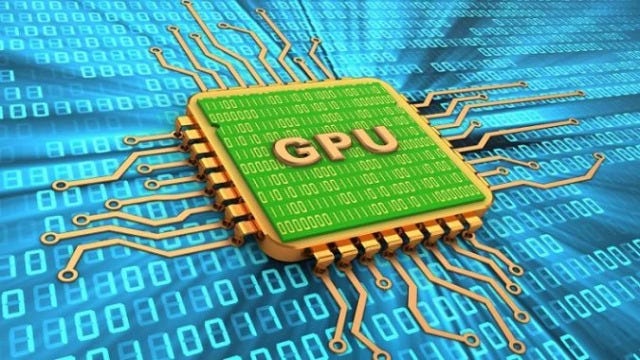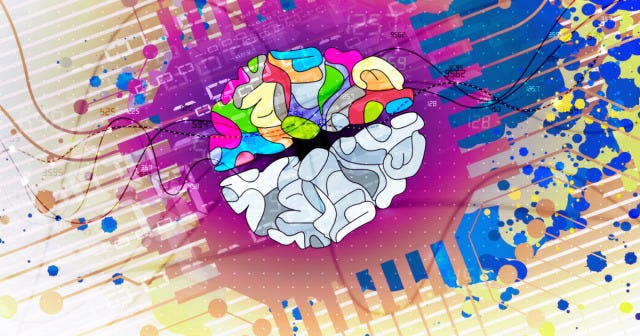GPU = Gpu Percentage going… Up
Here are some numbers that justify my “web3” thesis. First, recall that I use “web3” to include blockchain, AI, metaverse, etc. - because I can; see here. Second, these numbers work because I cherry picked them to prove my point; i.e., they may be wrong and naively thrown together, but it all makes sense directionally. So, without further ado….
40M GPUs / 400M CPUs = 10%; and that’s going… up.
The global market for CPUs is somewhere around 400M units per year. The global market for GPUs is somewhere around 40M units per year. So assuming these figures are accurate (they’re not), then the “attach rate” of GPUs to CPUs is about 10% because every GPU requires a CPU to function. Does this mean that the attach rate will approach 100% and the GPU market will increase tenfold? Probably not, but maybe. Regardless, it will be multiples larger than it is today; i.e., that 10% figure is going… up (a lot) because AI, blockchain, metaverse etc. require GPU compute power and every device, application, tool, etc. will be adding AI, blockchain, metaverse, etc. capability.
[[MORE]]
Obligatory history lessons (and gratuitous victory laps).
The sector call I made in 1997 was that effectively 100% of US homes had computers, but only 20% were connected to the Internet. And 100% of new computers sold were connected to the Internet so that gap between 20% and 100% would close to zero (spoiler alert: it did); TLDR: buy ISP stocks (and everything Internet, for that matter). It was the right call in terms of what happened to the percentage of computers connected to the Internet and it was the right stock call for a few years (before it was a very wrong call, but let’s gloss over that for now).
And in 2011, I wrote here that there were ~240 million cell phone accounts in the US, of which only ~30% were smart phones, but soon everyone would have a smart phone with a data plan. So if 80% of the 70% that didn’t have data plans got plans (spoiler alert: they did, and then some), then >130 million new data plans would be created at ~$30/month for almost $50 billion in incremental annual revenue to the carriers, roughly half of which is incremental free cash flow.
And when I joined AWS in 2014, <10% of total IT spend was cloud, but effectively 100% of startups were using cloud. (Reference point: AWS 2014 revenue turned out to be around $4.6B.) Would that mean that IT spend allocation to cloud would go to 100%? Had no idea; but figured it would go… up. (Update: AWS did $80B+ in 2022 - right again!)
What’s under the headline numbers?
All of those calls or even this (GPU attach rate) call are reasonably obvious; they’re big numbers and the (ISP, mobile, cloud, GPU chip) companies have been direct beneficiaries, but it’s also the implications for nearly every sector of society and the economy that can warp your brain. E.g., in the smart / cellphone example from 2011, someone had to build equipment, buy equipment, install boxes, climb cell towers, administrate, manage, market, support, etc., which goosed both white collar and blue collar labor, and created new jobs categories like social media marketer, influencer and manager. And then the productivity gains from mobile (and social and cloud) computing ensued.
So what now?
I don’t think it’s difficult to see the productivity gains to come from AI. (Blockchain and metaverse take a little more squinting, but they’re there - e.g., financial transaction cost reduction, healthcare processing efficiency, communications optimization, advertising economics.) And I appreciate the anxiety that AI in particular creates over (likely tectonic) employment dislocations. But creating, building, and managing all of this infrastructure requires participation from existing (e.g., engineering, hardware assembly, creative design, etc.) and emerging (e.g., prompt engineering) vocations.
Right now (mostly) Nvidia (and a few other companies) can’t come close to building enough chips to meet demand; Nvidia already raised its revenue forecast by 50% after reporting blowout earnings. While the large cloud providers plead for (compute) power from Nvidia and its brethren, those same companies are designing their own chips (like Google’s TPU) or cutting deals with other providers (e.g., Microsoft / Coreweave, which, entirely not ironically enough, lists Nvidia as an investor) to gain GPU access. And, as per BI, VCs, worried about limited access to GPUs for their portfolio companies, started buying GPUs directly(!)
At Computex this year, Nvidia’s CEO predicted an accelerated computing data center of the future powered by GPUs that has a 20-40x cost advantage over today’s CPU-based data centers; specifically, one LLM would cost $10M for 960 CPU-based servers that would require 11 GW of power, whereas the same $10M would buy 48 GPU-based servers that could train 44 LLMs using one-third the energy. Blockchain enthusiasts, meanwhile, are looking to FPGAs as an alternative to GPUs for their high performance compute needs. To wit, Intel’s perennial arch enemy AMD bought Nvidia’s perennial arch (Canadian) enemy ATI in 2006 (smart), and last year the chip company completed its acquisition of Xilinx, one of the premier FPGA designers (smart again).
So the GPU market should increase 5-10x; big range, but there’s just no way the GPU:CPU “attach rate” remains at ~10%. For (at best) tangential context, as per above, the cloud computing’s share of total IT spend increased >5x (and total revenue increased even more than that). To build those GPUs requires semiconductor capital equipment, which may explain the US warships circling Taiwan (and, specifically, TSMC); it requires semiconductor design software, engineers, developers, etc. It also requires (peace?)ships to get products around the world and into data centers; as well as people to assemble, deliver, install, configure, code, and maintain servers.
The infrastructure rebuild also requires new software and tooling to make use of GPU technology, which is teaching a new generation of developers to build and use new products that every existing developer will use to build AI, blockchain, and metaverse applications. Nvidia’s CUDA has been around since 2006, but was mostly relegated to gaming and other niche market enthusiasts before every AI researcher on earth cut their teeth on the platform. And devs accustomed to Github, Python, and AWS will have to learn to spin up nodes and code in Solidity.
Beyond that, every application we know will be rewritten, updated, patched, glued, spackled, and painted to integrate these new technologies. Microsoft is already adding AI to all of its products in the form of Clippy Copilot. Adding Copilot to Word is a no-brainer, but what if Word didn’t exist and someone were to build a document creation application from scratch today (similar to how Google built Googledocs natively for cloud a decade ago)? Or a spreadsheet? Or a decentralized blockchain-based CRM platform?
Even with ubiquitous, cheap(er) high performance compute, we won’t see all applications move on-chain, but they will adopt blockchain for parts of their infrastructure to gain unique improvements in identity portability, security and authenticity, and efficiency. Most people won’t “see” the infrastructure changes, much like my mother-in-law has never waxed poetic to me about Netflix’s wonderful cloud infrastructure; she just likes that she can stream eclectic, tawdry, foreign-language TV shows on demand. (See Nick Ducoff’s piece “It’s Going to Be Blockchain, Not Crypto” for more.) Similarly, I don’t think we’ll see a Ready Player One-like version of Microsoft Word, but we’re already seeing attempts at decentralized social networking like Bluesky Social (without blockchain) and a ton more (using blockchain).
What will this all look like once AI, blockchain, and metaverse are ubiquitous? Just ask ChatGPT. TLDR: “…it’s not hard to imagine a future where your AI assistant helps you manage your day, your finances are entirely handled by blockchain-based applications, and you spend a significant portion of your day in the metaverse, working in a virtual office, hanging out with friends who live thousands of miles away, or exploring entirely new virtual worlds…. Privacy concerns, digital divide, mental health issues, cyber threats, job displacement due to automation, regulatory hurdles, and ethical implications are some of the potential issues…. The transition to this future will likely be gradual and require significant technological, societal, and regulatory adaptations….” I’d argue it will be gradual until it’s not.
Footnote: yes AI is hot; no metaverse is not dead (see here); yes blockchain is real and it’s not (just) crypto; FPGAs could be the next GPUs; and everything starts in gaming (or pornography).







